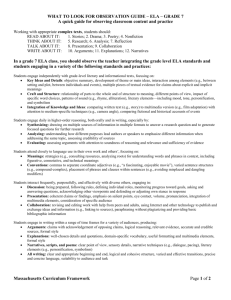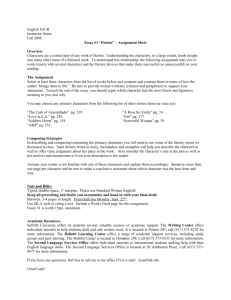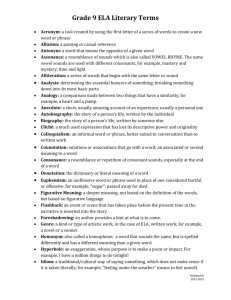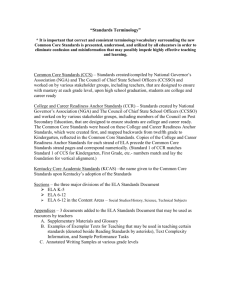Map: AP Lit and Comp Grade Level: 12 School Year: 2005
advertisement
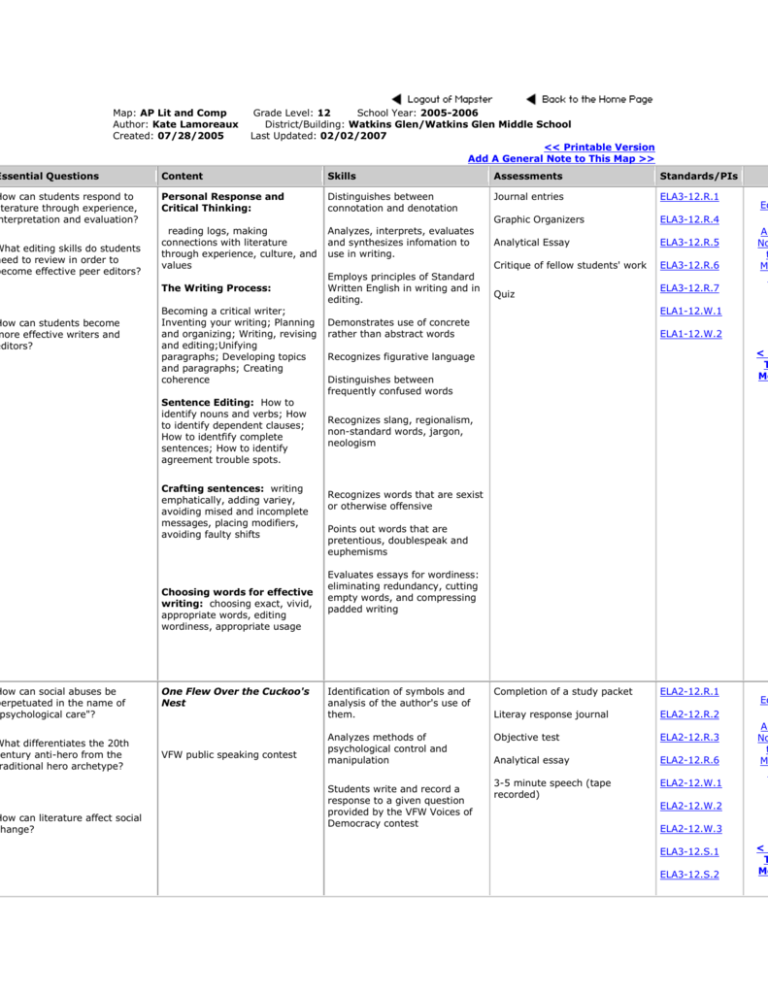
Map: AP Lit and Comp Author: Kate Lamoreaux Created: 07/28/2005 Grade Level: 12 School Year: 2005-2006 District/Building: Watkins Glen/Watkins Glen Middle School Last Updated: 02/02/2007 << Printable Version Add A General Note to This Map >> Essential Questions Content Skills Assessments Standards/PIs How can students respond to iterature through experience, nterpretation and evaluation? Personal Response and Critical Thinking: Distinguishes between connotation and denotation Journal entries ELA3-12.R.1 reading logs, making connections with literature through experience, culture, and values Analyzes, interprets, evaluates and synthesizes infomation to use in writing. Graphic Organizers ELA3-12.R.4 Analytical Essay ELA3-12.R.5 Critique of fellow students' work ELA3-12.R.6 What editing skills do students need to review in order to become effective peer editors? How can students become more effective writers and editors? How can social abuses be perpetuated in the name of psychological care"? What differentiates the 20th century anti-hero from the raditional hero archetype? How can literature affect social change? The Writing Process: Becoming a critical writer; Inventing your writing; Planning and organizing; Writing, revising and editing;Unifying paragraphs; Developing topics and paragraphs; Creating coherence Sentence Editing: How to identify nouns and verbs; How to identify dependent clauses; How to identfify complete sentences; How to identify agreement trouble spots. Crafting sentences: writing emphatically, adding variey, avoiding mised and incomplete messages, placing modifiers, avoiding faulty shifts Choosing words for effective writing: choosing exact, vivid, appropriate words, editing wordiness, appropriate usage One Flew Over the Cuckoo's Nest VFW public speaking contest Employs principles of Standard Written English in writing and in editing. Quiz ELA3-12.R.7 Ed Ad No t M > ELA1-12.W.1 Demonstrates use of concrete rather than abstract words ELA1-12.W.2 <P T Mo Recognizes figurative language Distinguishes between frequently confused words Recognizes slang, regionalism, non-standard words, jargon, neologism Recognizes words that are sexist or otherwise offensive Points out words that are pretentious, doublespeak and euphemisms Evaluates essays for wordiness: eliminating redundancy, cutting empty words, and compressing padded writing Identification of symbols and analysis of the author's use of them. Completion of a study packet ELA2-12.R.1 Literay response journal ELA2-12.R.2 Analyzes methods of psychological control and manipulation Objective test ELA2-12.R.3 Analytical essay ELA2-12.R.6 3-5 minute speech (tape recorded) ELA2-12.W.1 Students write and record a response to a given question provided by the VFW Voices of Democracy contest Ed Ad No t M > ELA2-12.W.2 ELA2-12.W.3 ELA3-12.S.1 ELA3-12.S.2 <P T Mo Creating and effective, convincing and emotionally powerful speech How are people's lives eflections of their social environment? Reading and Analyzing Fiction: How can I convey the essence of myself in a college essay? A Rose for Emily How does fantasy serve as a eflection of psychological, emotional and spriritual experience? What elements of modern humanity are recognizable in Aristotle's model of tragedy? ELA1-12.S.1 evaluation of audience The Story of an Hour The Destructors Everyday Use Paul's Case Infers details about characters and plot as a result of clues provided by the author. Selection tests College personal essay Compares various literary characters Literary response journal Ed Ad No t M > Recognizes the effect of time and place on the characters Hills Like Elephants Oxymandias Identify sources of irony <P T Mo College Essay Young Goodman Brown Dramatic reading Rocking Horse Winner Tests Oedipus the King: Greek Theatre: tragic hero, tragic flaw, hubris, Critical essay Ed Ad No t M > Aristotle's model for tragedy (The Poetics): plot-making, character delineation, thought & language, speech,song, & spectacle Theatre of Ancient Greece: Theatron, orchestra, skene, chiton, cothurni, properties, masks, male actors, masks, etc. Organic parts of the plot: recognition, pathos, compications, denouement Archetype, Quest motif, sacrificial scapegoat, Role of Chorus: Protogos, odes, Exodus. Stichomythis Dialogue Irony: verbal, situational, <P T Mo How have social stereotypes oppressed women? What is evil, and what drives men and women to commit dark deeds? dramatic Ibsen: The Doll's House Sojourner Truth: "Aint' I a Woman?" AP Test Practice What philosophies are common ELA2-12.R.1 Ed ELA2-12.R.2 ELA2-12.R.5 ELA2-12.R.6 Ad No t M > ELA2-12.W.2 ELA2-12.W.3 Miterm exam Literary Response Journal The Color Purple Macbeth Applies and illustrates the use of Literary Terms: tragedy, paradox, character, resolution, irong, blankverse, foreshadowing, suspense, mood, imagery, symbolism, metaphor, turning poing, dumb show, soliloquy, aside climax, tragic hero, theme, internal and external conflict, figurative language Literary Skills: What character changes reflect a coming of age"? What themes and images are common in Wordsworth's poetry? In class (short) essays Critical essays How does oppression occur and how can people overcome it? What distinguises Petrarchan, Spenserian and Shakespearean sonnets? Evaluates the literary elements used by specific authors to create an effect or theme AP Test Practice ELA2-12.W.1 What are the consequences of he freedom to make choices in ife? How do the messages of love in sonnets compare with those of modern poetry? Analyzes complex and sophisticated literary works Identifies key events in the plot Outlines cause/effect relationships in the plot Uses journal to answer questions for each act. Formal assessment: Act tests Formal essay: Macbeth <P T Mo Ed Ad No t M > Completes skill handouts Handouts on : plot, character attribute web, cause/effect graphic organizer, sociogram, literary analysis: similes & metaphors <P T Mo Uses journal to answer study guide questions for the novel Analyzes character development Formal essay: The Color Purple Sonnets: Analyzes sonnets Sir Thomas Wyatt: Whoso List to Hunt Interprets poems by considering the author's use of literary devices. Edmund Spenser: Sonnet 30, Sonnet 75 William Shakespeare: Sonnets 29,73,116,130 Poetic meter: iamb, trochee, anapest, dactyl,spondee, caesura Writes a comparative essay on: Tone Modern love (e.e. cummings' poem vs. Shakespearena sonnet) Discusses poetry in class. Explains poetry in joural Ed Ad No t M > Test: Whoso List to Hunt; Sonnets 30 & 75 Test: Shakespearen sonnets Literary response journal <P T Mo among Romantic poets? Scansion: feet; dimeter, trimeter, tetrameter, pentameter, hexameter Romantic Poets: Blake: The Tyger, The Lamb Wordsworth: Strange Fits of Passion Have I Known, She Dwelt Among the Untrodden Ways, A Slumber Did My Spirit Searl, The World is Too Much With Us Romantic Lyrics: apostrophes, blank verse, meditative poems, How do various types of change affect individual's lives? Women writers in the Romantic Period n what ways does death, or near death, impact people's ives? Ode, apostrophe, paradox, terza rima, assonance, What types of social and racial prejudice exist? Femme fatale, seducer, ballad Cold Sassy Tree Applies the term bildingsroman to the novel, citing examples of specific incidents that reflect Will's coming of age. Demonstrates and understanding of the novel's theme by selecting specific incidents which develop the theme Discusses methods of characterization. Demonstrates an understanding of the effect on Will of specific things things said or done by Miss Love. Analyzes the importatnce of specific journeys in the novel as they apply to the structure of the novel. Identifies specific incidents included by the author which are used to create readers' inferences about specific characters. These inferences are contrasted with the revelations which result from later events. Identify the use of language as a reflection of social status Interpretive Essay ELA2-12.R.1 Study packet ELA2-12.R.2 Journal entries ELA2-12.R.5 AP style Free-response essay tied to the novel ELA2-12.R.6 ELA2-12.W.1 Ed Ad No t M > ELA2-12.W.2 ELA2-12.L.2 ELA2-12.L.3 ELA2-12.L.1 <P T Mo s the topic of my choice worthy of research? Are there adequate sources elating to my topic? What is my opinion concerning my topic? How does one determine the quality of a source? What is the difference between a data base and a website? What organizational strategy will best support my thesis statement? MLA Format Research Strategies:Developing a bibliography, using an electronic library catalogue (OPAC), Electronic databases, AV resources, internet, periodicals, Boolean search, phrase search, keyword search Reading: Evaluating credibility of Working bibliography sources, Boolean search ELA3-12.R.1 ELA3-12.R.7 Notetaking: selecting main ideas and supporting details ELA1-12.W.1 Note cards Ed ELA3-12.R.5 ELA1-12.W.2 Ad No t M > Thesis statement Notecard Check Taking notes and documenting sources Inference, cause -effect, deductive and inductive reasoning Parallel sentence structure What determines the relability of data? Reading non-ficition and notetaking Writing: selecting and limiting a topic Writing a thesis sentence Listening Speaking Grammar Creating agreement between pronouns and their antecedents Rules for expressing numbers in written form Editing sentence fragments, comma splices, and run-ons Complex sentences Evaluates credibility of sources Paraphrasing and summarizing critical information as students take notes Analyzing material from diverse sources Arranging notecards and aligning them with a graphic organizer as pre-writing for a formal outline. Constructing a formal outline that reflects a logical pattern of argumentation Writng the rough draft, using Microsoft Word. Formal MLA outline Rough Draft <P T Mo What constitutes an effective ntroduction and conclusion? How can the student's opinion on a specific topic best be expressed and most convincingly supported? Editing strategies Writing in-text (parenthetical) citations Creating logical arguments Preparing a list of works cited, using MLA format Student evaluates his/her own paper, as well as that of a peer, using evaluation rubric Writes an introduction that establishes the writer as trustworthy, fair and interesting. Writes a conclusion that incorporates anecdotes, descriptions, quotations or figurative language to create a suitable emotional appeal 10-12 page paper with a title page, a formal outline, at least 10 parenthetical citations, an accurate works cited page ELA1-12.S.1 ELA1-12.W.2 ELA3-12.S.2 Oral presentation Ed ELA1-12.W.1 ELA3-12.S.3 Ad No t M > ELA3-12.S.1 <P T Mo Prepares an oral presentation to the class that summarizes the argumnent and support presented in the thesis. Standards used in this Map 12.R.1 [3 occurrences] - ELA Standard 2 - Reading Strand - Performance Indicator 12.R.01 - recognize and analyze the relevance of literature to contemporary an al events and situations from short stories, novels, plays, film and video productions, poems, and essays - read and discuss literary criticism - engage in a variety rative conversations, such as peer-led discussions, paired reading and responding, and cooperative group discussions, to make applications of the ideas in the tex ituations, extending the ideas to broaden perspectives [Grade 12] 12.R.2 [3 occurrences] - ELA Standard 2 - Reading Strand - Performance Indicator 12.R.02 - read, view, and respond independently to literary works that represe of social, historical, and cultural perspectives [Grade 12] 12.R.3 [1 occurrence] - ELA Standard 2 - Reading Strand - Performance Indicator 12.R.03 - compare a film, video, or stage version of a literary work with the wri [Grade 12] 12.R.5 [2 occurrences] - ELA Standard 2 - Reading Strand - Performance Indicator 12.R.05 - read and interpret literary texts from a range of authors, genres, and s, including literary criticism [Grade 12] 12.R.6 [3 occurrences] - ELA Standard 2 - Reading Strand - Performance Indicator 12.R.06 - interpret multiple levels of meaning and subtleties in text [Grade 12] 12.R.1 [2 occurrences] - ELA Standard 3 - Reading Strand - Performance Indicator 12.R.01 - analyze and evaluate nonfiction texts, including professional journals al manuals, and position papers, to determine the writer’s perspectives, purposes, and intended audience - identify text structure, using supports such as graphic ers - preview a text (e.g., in order to build a schema), noticing structural markers, such as headings and subheadings - focus on key word/phrases that signal tha heading in a particular direction - identify the particular kinds of language used in particular texts [Grade 12] 12.R.4 [1 occurrence] - ELA Standard 3 - Reading Strand - Performance Indicator 12.R.04 - form opinions and make judgments about literary works by analyzing ing texts from more than one critical perspective, such as a social perspective [Grade 12] 12.R.5 [2 occurrences] - ELA Standard 3 - Reading Strand - Performance Indicator 12.R.05 - select, reject, and reconcile ideas and information in light of beliefs [ 12.R.6 [1 occurrence] - ELA Standard 3 - Reading Strand - Performance Indicator 12.R.06 - make judgments about the quality of literary texts and performances g personal and academic criteria, such as that found in literary criticism [Grade 12] 12.R.7 [2 occurrences] - ELA Standard 3 - Reading Strand - Performance Indicator 12.R.07 - analyze and evaluate the intellectual and/or emotional impact of spe n the reader [Grade 12] 12.W.1 [3 occurrences] - ELA Standard 1 - Writing Strand - Performance Indicator 12.W.01 - use and integrate a wide range of organizational strategies to presen ation [Grade 12] 12.W.2 [3 occurrences] - ELA Standard 1 - Writing Strand - Performance Indicator 12.W.02 - define the meaning of and understand the consequences of plagiaris gate college and university policies [Grade 12] 12.W.1 [3 occurrences] - ELA Standard 2 - Writing Strand - Performance Indicator 12.W.01 - write interpretive and responsive essays of approximately five pages s judgments and support them through references to the text, using direct quotations and paraphrase - explain how the author’s use of literary devices, such as y, stream of consciousness, and irony, affects meaning - engage in a variety of prewriting experiences, such as using a variety of visual representations, to expres etations, feelings, and new insights [Grade 12] 12.W.2 [3 occurrences] - ELA Standard 2 - Writing Strand - Performance Indicator 12.W.02 - use resources such as personal experience, knowledge from other co and independent reading to create literary, interpretive, and responsive text [Grade 12] 12.W.3 [2 occurrences] - ELA Standard 2 - Writing Strand - Performance Indicator 12.W.03 - maintain a portfolio that includes literary, interpretive, and responsi [Grade 12] 12.L.1 [1 occurrence] - ELA Standard 2 - Listening Strand - Performance Indicator 12.L.01 - interpret and respond to texts from a variety of genres, authors, and s [Grade 12] 12.L.2 [1 occurrence] - ELA Standard 2 - Listening Strand - Performance Indicator 12.L.02 - respond to authors’ reading and discussing their works [Grade 12] 12.L.3 [1 occurrence] - ELA Standard 2 - Listening Strand - Performance Indicator 12.L.03 - identify how format and language are used in presentations to nicate the author’s message and evoke a response [Grade 12] 12.S.1 [2 occurrences] - ELA Standard 1 - Speaking Strand - Performance Indicator 12.S.01 - prepare and give presentations to a variety of audiences on a range ational topics, using a variety of techniques, such as multimedia, group presentations, and dramatic approaches [Grade 12] 12.S.1 [2 occurrences] - ELA Standard 3 - Speaking Strand - Performance Indicator 12.S.01 - express opinions and make judgments about ideas, information, nces, and issues in literary, scientific, and historical articles, in public documents, and in advertisements [Grade 12] 12.S.2 [2 occurrences] - ELA Standard 3 - Speaking Strand - Performance Indicator 12.S.02 - present reasons, examples, and details from sources such as films t opinions or judgments [Grade 12] 12.S.3 [1 occurrence] - ELA Standard 3 - Speaking Strand - Performance Indicator 12.S.03 - respond to constructive criticism [Grade 12]



